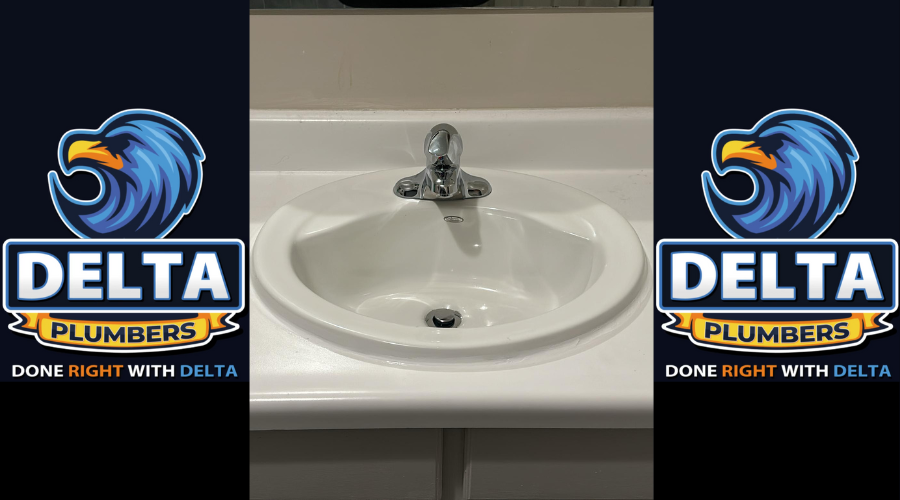Faucet leaks are a common household issue that can lead to water wastage and increased utility bills. As a trusted name in the plumbing industry, Delta Plumbers is here to guide you through the process of preventing and fixing leaky faucets. In this comprehensive blog, we will cover various aspects of faucet leaks, including their causes, solutions, and the importance of timely repairs. By following our expert advice, you can save water, reduce expenses, and maintain a well-functioning plumbing system in your home.

Picture Source – Delta Plumbers
How Can I Stop My Faucet from Dripping?
Stopping a dripping faucet involves identifying the type of faucet and addressing the root cause of the leak. Here’s a step-by-step guide to help you fix a dripping faucet:
Identify the Type of Faucet:
Faucets can be categorized into four main types: compression, ball, cartridge, and ceramic disk. Knowing the type of faucet you have is crucial for selecting the correct repair method. Compression faucets have separate hot and cold water handles that require you to tighten a washer to stop the flow of water. Ball faucets, often found in kitchens, have a single handle that controls a ball mechanism to mix hot and cold water. Cartridge faucets can have one or two handles and use a cartridge to control water flow. Ceramic disk faucets are known for their durability and have a ceramic cylinder to control water flow.
Turn Off the Water Supply:
Before you begin any repairs, turn off the water supply to the faucet. This can usually be done by shutting off the valves under the sink. If you cannot locate the shut-off valves, you may need to turn off the main water supply to your home.
Disassemble the Faucet:
Use a wrench or screwdriver to remove the faucet handle and other components. Be sure to keep track of the parts and their order for reassembly. Lay out the parts in the order you remove them, and take pictures if necessary to help with reassembly.
Inspect the Components:
Check for worn-out washers, O-rings, and seals. These are common culprits for leaks in compression and cartridge faucets. For ball and ceramic disk faucets, inspect the inlet seals and springs. Look for signs of wear, cracking, or mineral buildup.
Replace Damaged Parts:
Purchase replacement parts from a hardware store and install them in place of the damaged components. Ensure that the new parts match the old ones in size and type. It may be helpful to bring the old parts with you to the store to ensure an exact match.
Reassemble the Faucet:
Carefully reassemble the faucet, ensuring that all parts are properly aligned and tightened. Be gentle to avoid stripping threads or overtightening, which can cause further damage.
Turn On the Water Supply:
Restore the water supply and test the faucet for leaks. If the dripping persists, you may need to repeat the process or consult a professional plumber.
Also Read: Common Plumbing Problems and How to Fix Them

Picture Source – Delta Plumbers
What is the Most Common Cause of a Leaky Faucet?
The most common cause of a leaky faucet is worn-out or damaged components. Over time, the washers, O-rings, seals, and other internal parts of a faucet can degrade due to regular use, mineral buildup, and water pressure. When these components wear out, they can no longer create a tight seal, leading to leaks.
Worn-Out Washers:
In compression faucets, the washers are often the primary cause of leaks. These washers press against the valve seat to stop the flow of water, and they can become worn or dislodged over time.
Damaged O-Rings:
In cartridge and ball faucets, the O-rings are more likely to be the source of the problem. O-rings are small rubber rings that create a seal around the valve seat. They can wear out or crack due to constant use and exposure to water.
Corroded Valve Seats:
The valve seat is the part of the faucet where the spout meets the base. It can become corroded or worn over time, causing leaks. Regular maintenance, such as cleaning the valve seat, can help prevent leaks.
Mineral Buildup:
Hard water can cause mineral buildup on faucet components, leading to leaks. This buildup can be cleaned with vinegar or a commercial descaler to restore proper function.
Regular maintenance and timely replacement of these parts can help prevent leaks and extend the lifespan of your faucet.
Also Read: Sewer Repair Service: A Comprehensive Guide

Picture Source – Delta Plumbers
Why Does My Faucet Drip After I Turn It Off?
A faucet that drips after being turned off is typically due to residual water pressure in the plumbing system or a faulty valve seat. Here are some common reasons for this issue:
Residual Water Pressure:
When you turn off the faucet, the water that remains in the pipes can still flow out, causing a few drips. This is usually normal and should stop after a short while. If the dripping continues, it may indicate a deeper issue with the faucet components.
Faulty Valve Seat:
The valve seat connects the faucet to the spout and can become corroded or worn over time. A damaged valve seat can cause water to leak even when the faucet is turned off. Regular inspection and cleaning of the valve seat can help prevent this issue.
Worn-Out Washer or O-Ring:
In compression faucets, a worn-out washer may not create a proper seal, leading to drips. Similarly, in cartridge and ball faucets, a damaged O-ring can cause leaks. Replacing these components can often resolve the issue.
Loose or Damaged Parts:
Over time, parts of the faucet may become loose or damaged, causing water to leak even when the faucet is turned off. Tightening or replacing these parts can help stop the dripping.
To fix this issue, you may need to replace the worn-out parts or clean the valve seat to ensure a proper seal. If the problem persists, it is advisable to consult a professional plumber.
Also Read: Faucet Installation: A Comprehensive Guide by Delta Plumbers

Picture Source – Delta Plumbers
How Do You Fix a Slow Leak in a Kitchen Faucet?
Fixing a slow leak in a kitchen faucet involves identifying the source of the leak and replacing the damaged components. Follow these steps to address a slow leak:
Turn Off the Water Supply:
Locate the shut-off valves under the sink and turn off the water supply to the faucet. This will prevent water from flowing while you work on the faucet.
Disassemble the Faucet:
Remove the faucet handle and other components to access the internal parts. Keep track of the parts and their order for reassembly. It may be helpful to take pictures or make notes as you disassemble the faucet.
Inspect for Damage:
Check the washers, O-rings, seals, and other components for signs of wear or damage. In some cases, mineral buildup may also be the cause of the leak. Look for cracks, tears, or other signs of wear.
Clean or Replace Parts:
Clean any mineral buildup using vinegar or a commercial descale. Replace any damaged or worn-out parts with new ones. Be sure to use parts that are designed for your specific faucet model.
Reassemble the Faucet:
Carefully reassemble the faucet, ensuring that all parts are properly aligned and tightened. Follow the order in which you removed the parts to ensure proper reassembly.
Test the Faucet:
Turn on the water supply and test the faucet for leaks. If the slow leak persists, you may need to repeat the process or seek professional assistance.
Slow leaks can often be fixed by replacing a few small parts, but if you are unsure or the leak continues, it may be best to call a professional plumber for help.
Also Read: Best Plumber: How to Find One Near You

Picture Source – Delta Plumbers
How Do I Stop a Constant Dripping Tap?
A constantly dripping tap can be both annoying and wasteful. To stop a constant drip, follow these steps:
Turn Off the Water Supply:
Shut off the water supply to the faucet by turning off the valves under the sink. If you cannot locate the shut-off valves, you may need to turn off the main water supply to your home.
Disassemble the Faucet:
Remove the faucet handle and other components to access the internal parts. Keep track of the parts and their order for reassembly.
Inspect for Damage:
Look for worn-out washers, O-rings, seals, and other components. In some cases, the valve seat may also be damaged. Check for cracks, tears, or other signs of wear.
Replace Damaged Parts:
Purchase replacement parts from a hardware store and install them in place of the damaged components. Ensure that the new parts match the old ones in size and type.
Reassemble the Faucet:
Carefully reassemble the faucet, ensuring that all parts are properly aligned and tightened. Be gentle to avoid stripping threads or overtightening, which can cause further damage.
Turn On the Water Supply:
Restore the water supply and test the faucet for leaks. If the dripping continues, you may need to consult a professional plumber for further diagnosis and repair.
A constant drip is often a sign of a more serious issue, such as a damaged valve seat or significant wear on internal components. If you cannot fix the problem yourself, it is best to seek professional help.
Also Read: Boiler Installation Services by Delta Plumbers

Picture Source – Delta Plumbers
Why a Leaking Tap Should Be Repaired Immediately?
Repairing a leaking tap immediately is essential for several reasons:
Water Conservation:
A leaking tap can waste a significant amount of water over time, contributing to water scarcity and higher utility bills. Fixing the leak promptly helps conserve water. A single dripping faucet can waste hundreds of gallons of water per year.
Preventing Damage:
Continuous leaks can cause water damage to sinks, countertops, and cabinetry. Over time, this can lead to costly repairs and potential mold growth. Water damage can weaken the structure of your home and create a breeding ground for mold and mildew.
Saving Money:
A dripping tap can increase your water bill. By fixing the leak, you can reduce your water usage and save money on your utility bills. The cost of repairing a leaking faucet is often much lower than the cost of the water wasted over time.
Environmental Impact:
Wasting water has a negative impact on the environment. By repairing leaks, you contribute to the conservation of this precious resource. Water is a finite resource, and conserving it helps protect the environment.
Maintaining Plumbing Health:
Regularly addressing leaks helps maintain the overall health of your plumbing system. Ignoring leaks can lead to more significant issues, such as pipe corrosion and decreased water pressure. Leaks can also create pressure imbalances in your plumbing system, leading to further damage.
Ignoring a leaking tap can lead to more serious problems down the line. By addressing leaks promptly, you can avoid costly repairs and maintain a healthy plumbing system.
Also Read: Leak Detection and Repair: All You Need to Know in 2024

Picture Source – Delta Plumbers
Is It Okay to Leave a Faucet Dripping?
While it may seem harmless to leave a faucet dripping, doing so can have several negative consequences:
Water Wastage:
Even a slow drip can waste a considerable amount of water over time. This is not only wasteful but also increases your water bill. A single drip per second can waste over 3,000 gallons of water per year.
Increased Costs:
The cost of wasted water adds up, leading to higher utility bills. Fixing the leak can save you money in the long run. The cost of a simple repair is often much less than the cost of the wasted water.
Potential Damage:
Continuous dripping can cause water damage to sinks, countertops, and surrounding areas. This can result in expensive repairs and potential mold growth. Water damage can weaken the structure of your home and create a breeding ground for mold and mildew.
Plumbing Wear and Tear:
Allowing a faucet to drip can put additional strain on your plumbing system, leading to further wear and tear. This can result in more frequent repairs and replacements. Constant dripping can create pressure imbalances in your plumbing system, leading to further damage.
Environmental Impact:
Wasting water has a negative impact on the environment. By fixing leaks promptly, you contribute to water conservation efforts. Water is a finite resource, and conserving it helps protect the environment.
Conclusion
Leaky faucets are a common issue that can lead to water wastage and increased utility bills if not addressed promptly. By understanding the causes of faucet leaks and following the steps outlined in this blog, you can effectively prevent and fix leaky faucets in your home. Remember to regularly inspect and maintain your faucets to ensure they remain in good working condition. If you encounter any difficulties or the leaks persist, don’t hesitate to contact Delta Plumbers for professional assistance. Our team of experts is here to help you with all your plumbing needs, ensuring a well-functioning and efficient plumbing system in your home.









